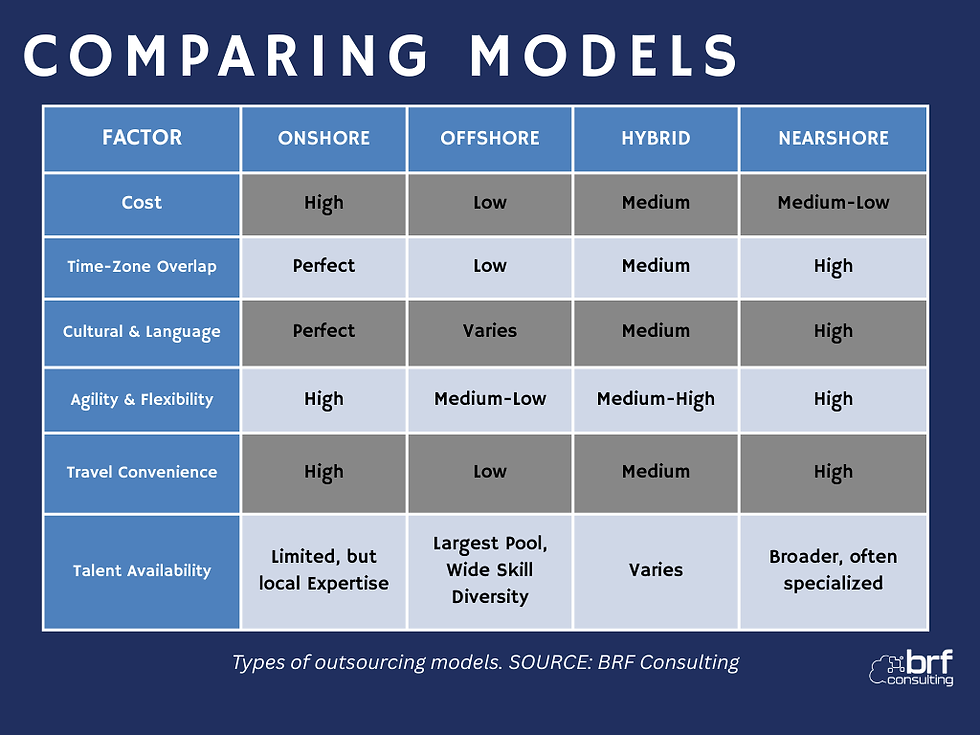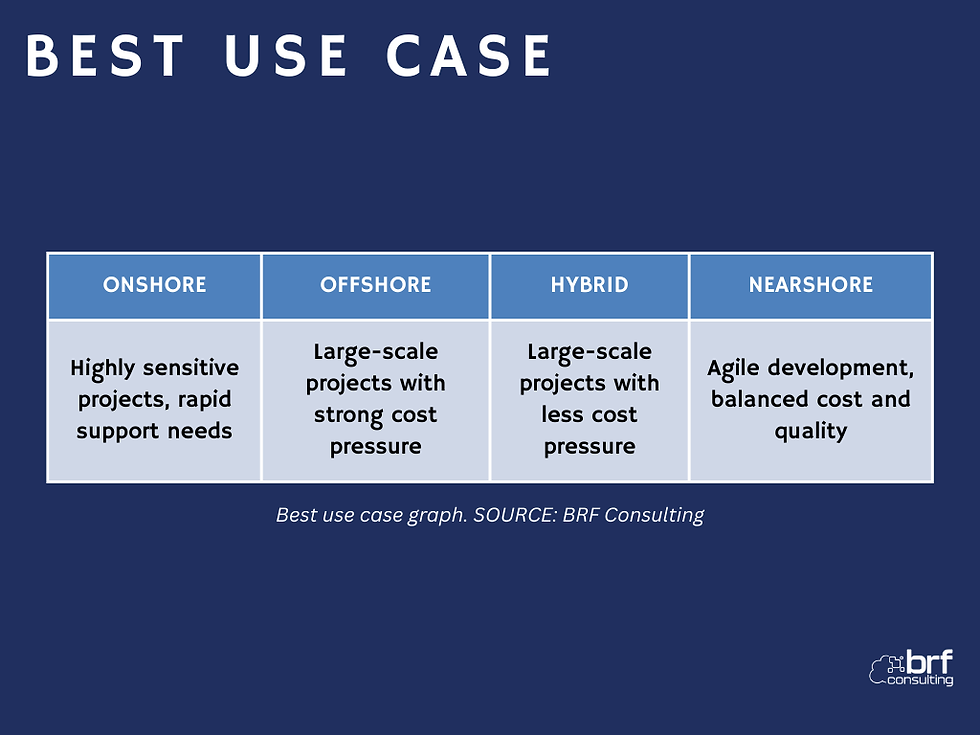Why your company should work with a nearshore consulting IT team?
- Anna Lopes

- Sep 9
- 8 min read
Updated: Sep 10
Considering the challenges in today’s fast-paced technological world, when should a company consider hiring an IT consulting firm? And which consulting model should it choose?
With numerous software programs available today, companies must choose one that best fits their needs. Unfortunately, even when a software seems perfect for a business, it can have limitations that may hinder the company’s entire workflow and even its bottom line.
That’s when an IT consulting business should be considered: to figure out how to make any software scale smarter for that company.
But with significant challenges in IT projects, such as communication barriers, time zone differences, rising costs, and the need for agile and faster delivery, to name a few, who should your business hire: an onshore, offshore, hybrid, or nearshore consulting business model?
In a recent webinar, BRF Consulting (BRF) and Red Pill Analytics (RPA) demonstrated how working as nearshore consulting partners has benefited many clients.
The decision depends on factors such as cost efficiency, time zone alignment, cultural and language proximity, agility and flexible collaboration, quality and talent access, and reduced travel costs and time.
“[Nearshore consulting] has proven over and over again to be a winning model for the modern IT projects,” says William Both, a consultant with BRF.

What is nearshore consulting?
Nearshore consulting is a business approach where companies outsource their IT services to providers in nearby countries or regions.
RPA’s Robert Barnes says that when Red Pill Analytics was formed in 2014, the idea was to create a different way of doing business, avoiding the 8-hour billing and the “jack of all trades, master of none” type of consultant.
Through its consulting boutique shop, RPA started partnering with companies that offer “capacity analytics” or “elastic delivery,” leveraging their ability to bring in resources and young, talented individuals eager to learn new technologies to stay ahead of the curve.
“The nice thing about working with BRF in our nearshore model is the fact that the team that we work with has been with us now since 2017, [so] when I call and ask them for a resource, they understand what our needs are, the communication and the partnerships are already there,” Barnes explains.
With consultants ready on short notice, RPA and BRF can quickly ramp up and keep projects going, while aligning costs.
“We're able to deliver products at a very reasonable cost to the client, and scale with enterprise partners or even small startups,” Barnes adds. “That's our approach for this combined team effort that I refer to as combined capacity analytics.”
Who should consider using it?
The nearshore model can benefit businesses of all sizes, large and small, in varied fields: financial, medical, manufacturing, transportation, information, IT and consulting services, communications, commerce, education, and many more.
“Nearshore is ideal for organizations seeking agility as well as strong communication, either daily or in particular for those face-to-face communication opportunities,” Both says.
Also, “[it] is ideally situated for companies that are going for rapid development, and looking for a good balance between cost and quality of the resources. So it's like the best of both worlds, where you're getting the same amount of the same quality of your resources that you'd find anywhere else, but at a much better rate.”

While “a lot of the larger consulting firms are leveraging [the hybrid] model nowadays to help average it down the cost of the project itself.”
*BRF Consulting and Red Pill Analytics hosted this webinar on August 28, 2025.
Q & A
What types of companies or industries benefit the most from a nearshore IT consulting approach?
William Both: The initial gut reaction would be mainly targeted towards small to medium-sized companies looking for a rapid, agile implementation. However, one of the distinguishers that we made in the best use cases slide is that large-scale projects can also benefit significantly from a nearshore model and if you're leveraging an offshore model. Because of the pricing similarities between offshore and a nearshore model, if you wanted to do a large-scale implementation, and you did have those same cost pressures to try to keep the cost down, you're going to find there's very little difference between the offshore model and the nearshore model.
The other factors of the collaborative nature, proximity, and the ability to be a little more agile and reactive with a nearshore model needed to be highlighted more. But that does not discount nearshore from being capable of doing a large-scale project that also has cost pressures put upon it.
Robert Barnes: We come to the table with a boutique shop presence, and at the same time, we can deliver in multiple ways, such as nearshore or hybrid with offshore. And if the company says, ‘I just can't handle offshore,’ most of the time, the benefit is that we're in a fast-paced, agile environment, and we cannot afford to have a day delay from the time we discover something at noon today, and then have a developer work on it. There's a 13-hour time difference if you go completely offshore. So that’s the biggest drawback we have when we're working with offshore on fast-paced projects, and most of our stuff is fast-paced. They want out and delivered in short sprints.
So that's the biggest benefit for us, the ability to turn the stuff over quickly, the ability to work through bugs or any issues you may have as you're going live or in the development process, and when you're having short sprints. The cost also comes into play by us being able to leverage our onshore.
But the nearshore model blows up when your exchange rates change. So as the economies are changing and our exchange rates change, then the nearshore model, you lose some of the ability to reduce cost. Now it's a matter of bringing in expertise. We try to deliver everything with a senior-type person, but that would change as the economy changes in different areas.
Angelo Buss: So, not just in terms of industries, but also in terms of technologies, we try to learn as much as we can and get experience with artificial intelligence, for example, with all the latest technologies. We need to be ahead of whatever our clients need, so we have great people at BRF Consulting, great engineers, great talents. Everyone is always looking for new things to bring to our clients and partners.
What trends in the global workforce could make a nearshore it team a must-have for the near future?
Both: Minimizing the delay between issue identification and resolution. We've all had experience working with offshore teams where you have that eight-to-12-hour delay where during the day in the U.S., the issues are identified, but then it's not resolved by the developers until the following day. Whereas having that geographic proximity allows the resolution to be initiated as soon as the issue has been identified.
That is one of the key factors that make considering a nearshore component. It doesn't necessarily have to be the entire team, and oftentimes, nearshore teams work hand in hand with offshore teams, and that allows you to do that handoff. You get the best of both worlds: still paying a comparable rate for all your resources. However, you're able to have almost a 24-hour cycle of development, testing, and issue resolution or issue identification, even as a Solution Architect. So, there are some really strong arguments that an almost blended team that includes a nearshore component is a strong way to go.
Barnes: Being able to communicate with open discussions about what the client is asking for, and then you're given a detailed description of what the solution is going to be. So a lot of times, that is difficult to get through sometimes.
Those can be overcome, depending on how you build the team. If you have your client in India, and if your client-facing group is more with that culture, more with that communication language, and then you have somebody working with the back office team in another region, say in the U.S., as long as that communication happens, I think the big thing is just be being aware of the company's business, their business language, what they're really trying to do, and then being able to articulate that. Technology and programming are vital, as is being able to understand the business need and then offer a solution.
We still have companies running on spreadsheets. How are you going to talk about AI? So, we have to be aware of what can help a business grow, and that will be a must-have for the near future: understanding the industry, how to communicate that, and what solutions are available to help a company through its times.
Both: Robert, you bring up a good point there. I was part of a financial group project. Our discussion today has been primarily U.S.-client-centric; however, for the client over in Bahrain, we had exactly what I described earlier. We had a blended team. We had nearshore resources in India, but we also had offshore resources here in the U.S. supporting that particular client's project. That allowed us to have that 24-hour cycle where work could be collaborative, handed off, and continually developed in order to mainly handle a lot of issue resolution, and fine-tune the learning model for the AI chatbot itself.
Nearshore doesn't just mean who's supporting the U.S. It means wherever your client may be, whether it's in India, the Middle East, Europe, South America, or North America. In Asia, the nearshore component definitely needs to be considered because it is a huge force multiplier for a number of different reasons.
Apart from the time zone situation, are certain projects more appropriate for nearshore offshore teams?
Barnes: When I first started working with remote companies, and I've been remote now for almost 15 years – Red Pill went remote back before remote was cool and before the pandemic forced everybody to do that, – I basically told my folks, I don't really care where you're working from. I don't care what your hours are. I, so as long as these things happen: the project is delivered, your tasks are done on time, and it's transparent to the customer that they don't know where you are. By you being remote, it does not impact the customer, and they see it's a difference.
How do you define that nearshore is better than offshore?
Barnes: If you build the teams properly, and as long as the client doesn't see an impact, then it's hard to determine which one's better. When selling nearshore, from a perspective of RPA, we automatically assume that that will address the client's cost and timely turnover needs. But the same flip side would be that if I were doing a consulting company in India, my nearshore would be the same. I'm gonna look at cost versus time. So it depends on what defines nearshore. Nearshore to me is something close to the States. Nearshore for somebody in Pakistan or Guatemala would be something close to them. It's all about cost, delivery, and speed, and doesn't impact the client. So that's kind of my take on that.
*Q&A has been edited for clarity and length.
About the author: Anna Lopes is the Communications Associate for BRF Consulting, which specializes in Data Engineering, AI, Software Development, and Salesforce.com
Sources
William Both - Consultant at BRF Consulting
Robert Barnes - Managing Director at Red Pill Analytics
Angelo Buss - Founder of BRF Consulting



Comments